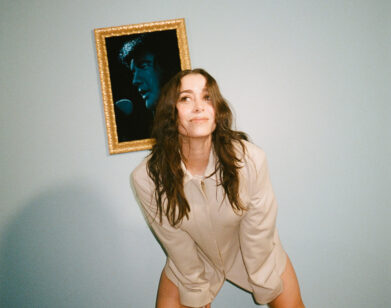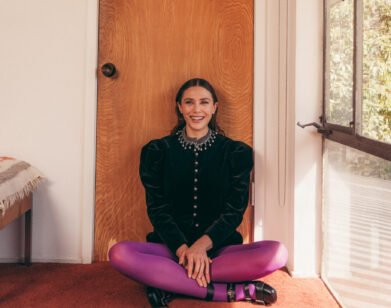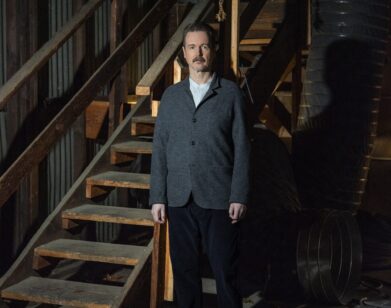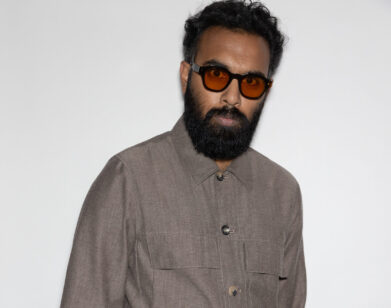Julian Schnabel’s Dual Creations
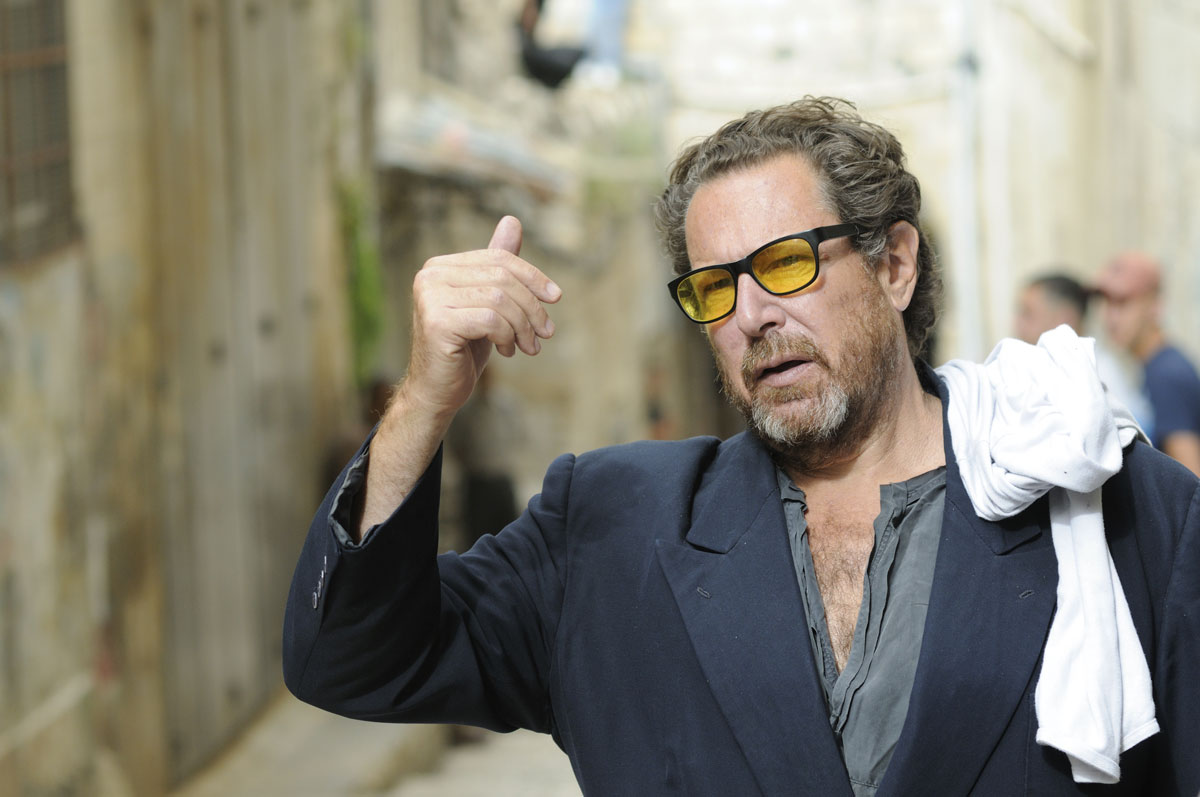
JULIAN SCHNABEL ON THE SET OF MIRAL. PHOTO COURTESY OF JOSE HARO
Julian Schnabel’s new film, Miral, is The Weinstein Company’s first release since winning four Academy Awards for The King’s Speech last month. As in Schnabel’s previous films—Basquiat, Before Night Falls and The Diving Bell and the Butterfly (which earned him an Academy Award nomination and Golden Globe and Cannes wins for Best Director)—the artist’s eye is lyrical and evocative as he meditates the experience of growing up amid the Israeli-Palestinian conflict. Freida Pinto (Slumdog Millionaire) portrays Miral, a young Palestinian girl who becomes swept up in the Intifada while teaching at a refugee camp in 1988.
Schnabel, whose mother was formerly president of the Brooklyn chapter of the Women’s Zionist Organization, Hadassah, dedicates the film (in the closing credits) to “everyone on both sides who still believes peace is possible.” The screenplay by Schnabel’s girlfriend Rula Jebreal, adapted from her book, emphasizes the characters’ humanity, particularly the tenderness between Miral and her father (the nuanced Alexander Siddig). The film also features performances by Willem Dafoe, Vanessa Redgrave, and Stella Schnabel and music by Tom Waits and Laurie Anderson.
We met with Schnabel at Palazzo Chupi, his West Village home/studio, with its famed pink tower (which reminded us of Albert Milo’s studio visit in Basquiat, where the parting advice of Schnabel’s alter ego to Basquiat is “more pink”). He was wrapping up a congratulatory phone call from Sean Penn, who had attended Miral‘s premiere with Robert De Niro at the United Nations General Assembly Hall, where Dan Rather moderated a panel discussion about the issues raised by the film.
Although much of Schnabel’s painting is done at his Montauk studio—a space open on three sides to the ocean—we visited his home studio, where several recent paintings are displayed. Entering Schnabel’s workspace is akin to entering a cathedral—the visitor is viscerally overwhelmed and engulfed by the sheer enormity and presence of the magnificent paintings—and a simple wooden crucifix stands to the left of his Apple laptop, with a small portrait of Dennis Hopper hung above it, like an icon, across from a wooden table with dozens of cans of oil paint. Schnabel usually paints his tarps and canvases on the floor, often while listening to Tom Waits, the Rolling Stones, or Otis Redding. Next to two violet-and-cream paintings from the 1989 “Bingo” series are two series created in the last few months.
While the works for his upcoming exhibition, “Permanently Becoming: Julian Schnabel and the Architecture of Seeing,” at the Museo Correr during the Venice Biennale, have already been shipped, some of his new works—painted over images of the Hindu god Shiva and vintage X-rays—will likely see inclusion in a retrospective Jeffrey Deitch is planning for L.A. MOCA next year. The “Shiva” paintings are breathtaking departures from Schnabel’s sparse, linear-on-color-field works, with dense, multi-colored geometric (almost early-Cubist) planes in oil superimposed upon huge prints of the deity. The dramatic x-ray paintings consist of enigmatic shadows and magnified outlines of bones, with slashes of oil paint bolting across the images like lightning storms.
We sat down with Schnabel to discuss Miral and his painting.
LORRAINE CWELICH: What compelled you to make this film and tell this story?
JULIAN SCHNABEL: I felt somebody had to do it. I didn’t know anything about it, really, and through the reading of Rula’s book, I thought telling the story of a Palestinian girl would be something worth doing and something I hadn’t done before was to tell a story about women, from their point of view. As a Jewish person also, I felt that we need to listen to the other side, to try to have more humanity and empathy.
CWELICH: What message do you want the audience to take from this film?
SCHNABEL: I think the film is a poem; it’s a cry for peace. We have to look at people as human beings and think of people not as groups and statistics but as personal stories, a family; all Palestinians are not the same; all Israelis are not the same. There are many different stories to be told, but I’m just trying to tell this one story, which touched me personally and I tried to be accurate with that.
CWELICH: Are you in favor of two separate states or one state?
SCHNABEL: I don’t care if it’s one state or two states; there’s not very much left. The movie said 22%; there’s not 5% left now. That’s about demographics. People just have to live together. When we made this movie, there were Israelis and Palestinians who worked together and they do, every day. There are Israelis and Palestinians who both want peace. And there are Palestinians and Israelis who are both fanatics and that should not be in charge. We’ve seen this great non-violent revolution going on in Egypt and parts of the Middle East and it should happen everywhere.
CWELICH: How do you respond to the controversy of the critics who say the film is pro-Palestinian?
SCHNABEL: It is a Palestinian story about Palestinian people. Do they have a right to have their story told? I think so. Do Palestinians deserve to live? Yes. To live with dignity and respect and safety, security and flourish and have what we have here? Yes. To have homes? Yes. It is the point of view of a 17-year-old girl; it is her vision, her story, her diary. When I told Jean-Do’s story in The Diving Bell and the Butterfly, it was Jean-Do’s experience; it’s Reinaldo Arenas’ experience, it’s Jean-Michel Basquiat’s experience, it’s Miral’s experience. It’s not Miriam’s experience, who is her Jewish counterpart.
CWELICH: It’s interesting that all your films have been biographies, loosely based on real people, rather than fictional characters.
SCHNABEL: Well, they are portraits more than biographies. I would have made a movie of [Patrick Süskind’s novel] Perfume; I had written a script for that and Jean-Baptiste Grenouille was a fictional character, but he was as real to me as Jean-Dominique Bauby [in The Diving Bell and the Butterfly].
CWELICH: Can you talk about the overlap between your paintings and the visual components of your filmmaking, such as your approach to the composition of a film frame and your use of color?
SCHNABEL: There was a 45-foot screen at the premiere at the U.N., and we watched the movie under the best circumstances. You realize why, when you make a movie, you don’t want to see it on television, or your computer; you want to see it on a screen—it’s like a painting when you do it like that.
CWELICH: It’s like viewing a reproduction of a painting online.
SCHNABEL: Exactly. And I thought about what you’re asking me when I watched the movie. When I see something in the foreground of the frame that’s out of focus and there’s something that’s just a green blurry shape, it’s not dissimilar from when you saw the white images in the front of the paintings as you came into the entrance of my house. I realized when I was watching the movie that I’m always right there, watching what’s happening at that moment—I’m not somebody who makes storyboards. I decide what kind of film I’m going to use, who’s going to be in the room, where the room is and follow what’s happening with the camera. You have to be premeditated to a certain extent, but ultimately, I’m looking for that spontaneous accident, that thing that’s going to happen. I don’t rehearse beforehand; I shoot the rehearsal. I want something to happen that’s never happened before. I don’t want somebody to do something great and then say, “That was great, can you do that again?”
CWELICH: So is it a collaboration between you and the DP or do you pretty much tell him exactly how you want a frame composed?
SCHNABEL: I decide how everything’s going to be. I ask somebody what they think, but if you look at my movies, there are different DP’s on all my movies, and they all look pretty much like the same person shot them. It’s the way that I look at the frame and look at the things coming in from the left and the right. One of my favorite moments in the movie is when the two girls are driving back and you hear that Laurie Anderson music and you just see a strand of hair going through the frame. If you think about when the girl jumps out the window in Before Night Falls and you see the hair of the lady looking down, just the strand of it going through, obviously there’s a kind of drawing going on with things that are in the foreground and the background. I don’t have a hierarchal notion of what needs to be inside the center of the frame, so there’s a kind of freedom that exists there, that I’m looking for.
CWELICH: How much of your time is currently devoted to painting?
SCHNABEL: Well, I’ve always spent most of my time painting. Even when I’m directing; obviously when I was in Israel it was harder, but I actually made works when I was there and when I was in Mexico making Before Night Falls. Actually, when I made all of my films, I’ve always painted. I’ve been working a lot.
CWELICH: Was your use of the Shiva image influenced by Miral?
SCHNABEL: Although Shiva is an Indian image, I think there’s an ethnographic quality to my work; that’s painted on a backdrop from the Kabuki theater in Japan. This [gestures] is painted on an army tarp, so obviously the materials that they are painted on are locators, placing them in time and geography and a lot of different magic confluences.
CWELICH: What are your thoughts on your upcoming retrospective that Jeffrey Deitch is planning for L.A. MOCA? Will you be contributing new works?
SCHNABEL: I think it’s great; it’s going to be a big show. I think there will be new works in that show; it depends how much space there’ll be.
CWELICH: Do you know yet how many paintings will comprise that exhibition?
SCHNABEL: Not yet, but I’m having a show at the Correr Museum in Venice during the Biennale this year and there will be about 40 paintings in that show.
MIRAL OPENS IN THEATERS TODAY.

